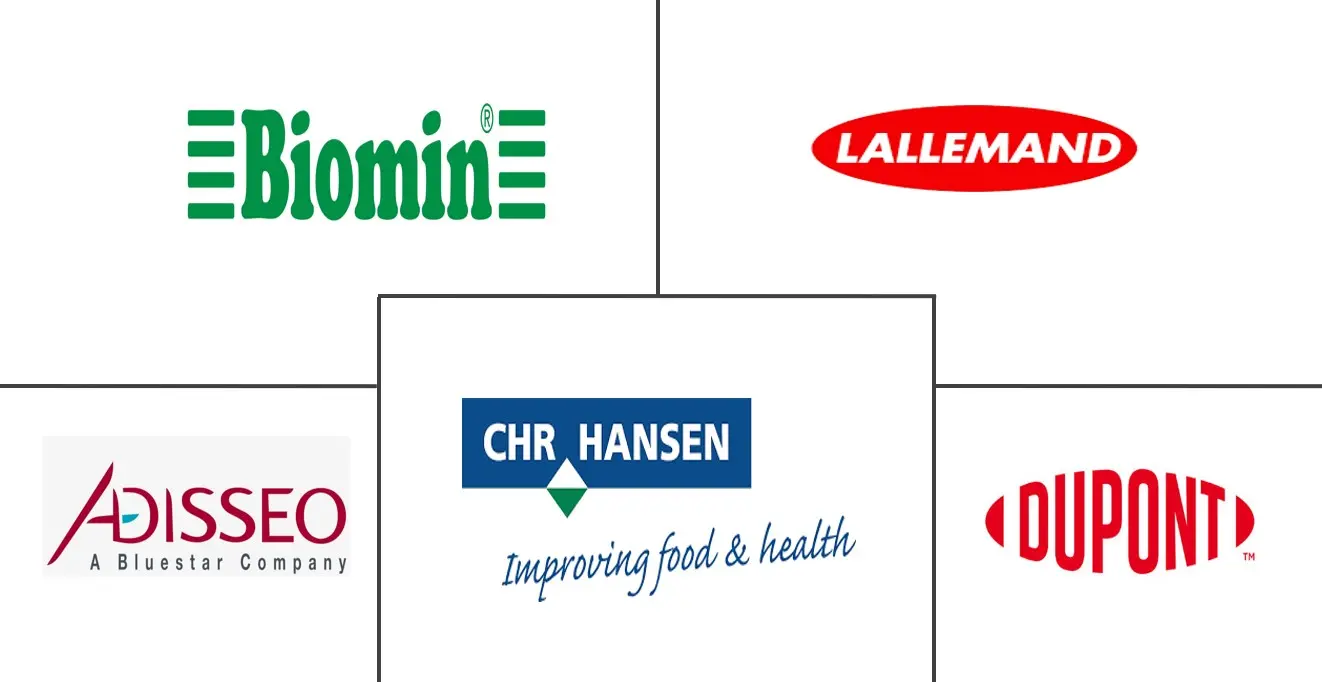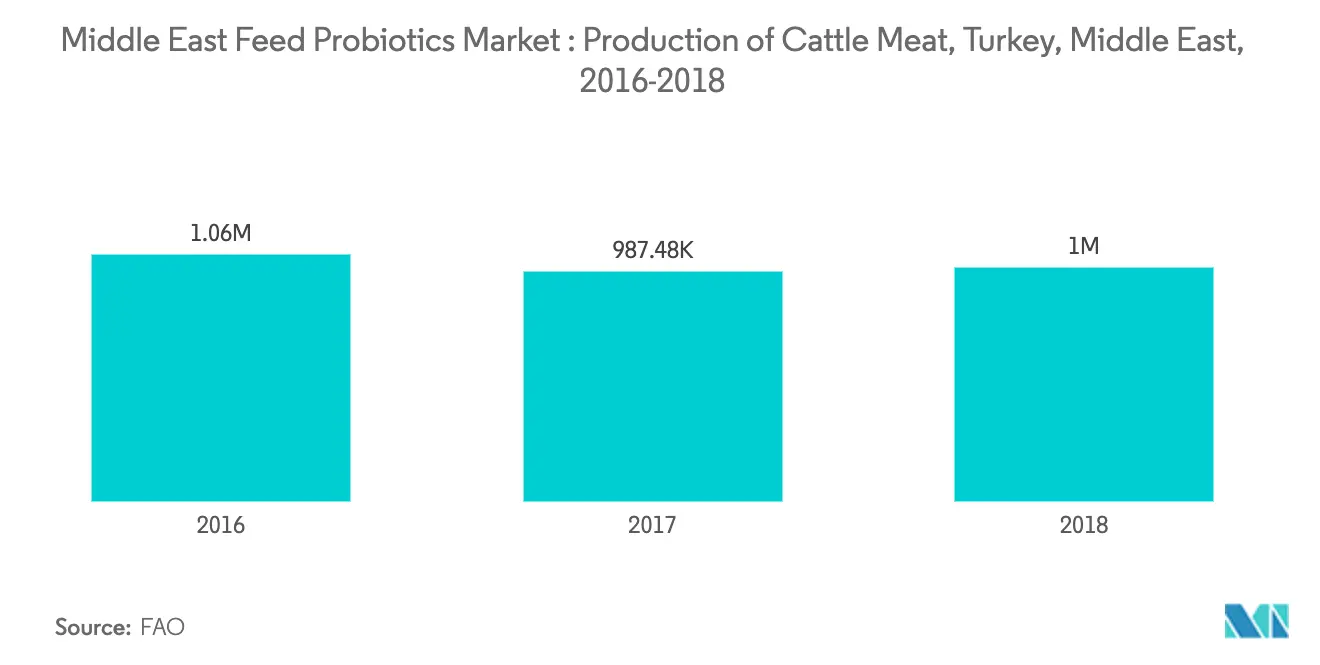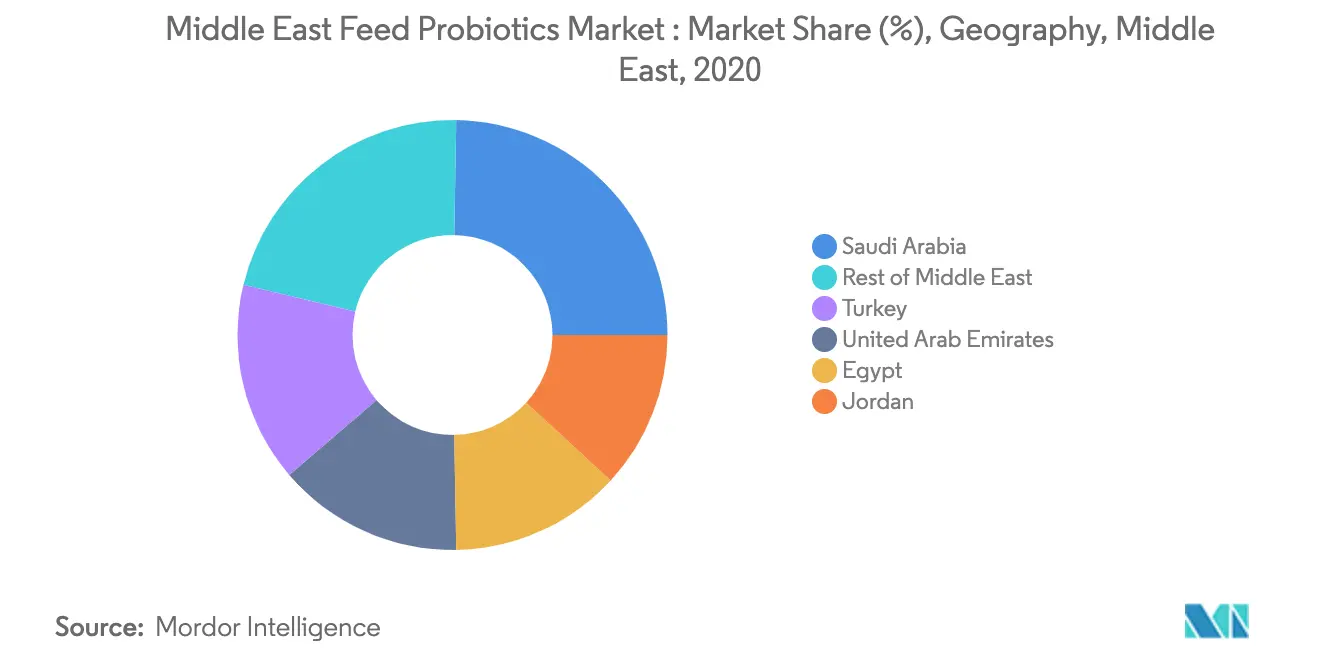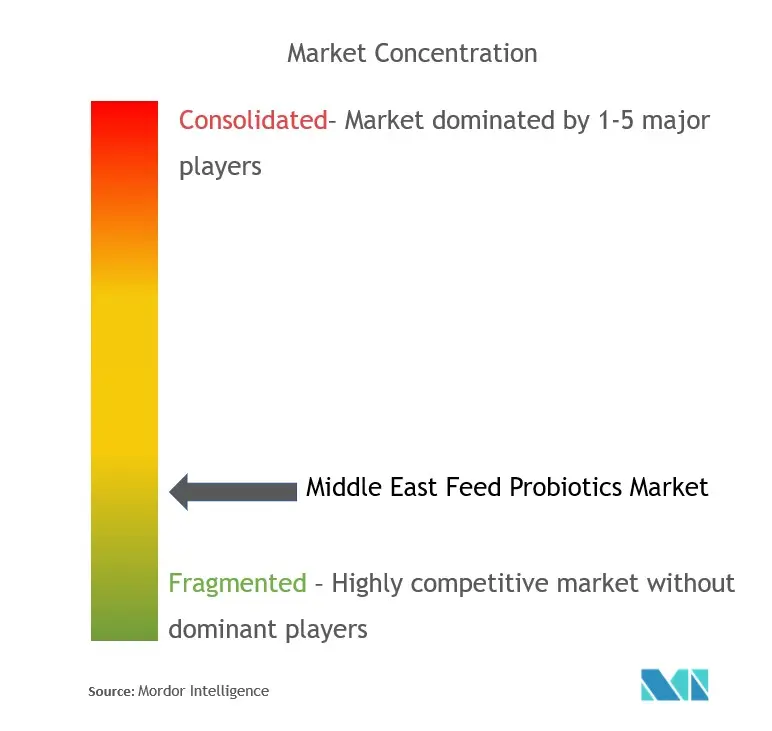ME Feed Probiotics Market Size

| Study Period | 2019 - 2029 |
| Base Year For Estimation | 2023 |
| Forecast Data Period | 2024 - 2029 |
| Historical Data Period | 2019 - 2022 |
| CAGR | 6.80 % |
| Market Concentration | Low |
Major Players
*Disclaimer: Major Players sorted in no particular order |
ME Feed Probiotics Market Analysis
The Middle-East feed probiotics market is projected to witness a CAGR of 6.8% during the forecast period (2021 - 2026). The animal feed industry had badly affected by the COVID-19 pandemic, which compelled farmers to stock their animal feed supplies, including additives such as probiotics. This had led to a spike in demand for animal feed additives when the lockdown was initially imposed.
Probiotics are widely used in farm livestock, companion animals, and aquaculture, as they are principally associated with reducing clinical disease and increasing growth rates. Therefore, as consumers are becoming more health-conscious, livestock producers are shifting toward sustainable livestock farming techniques, which may drive the market for probiotics.
The regional feed probiotics market is segmented based on product type and animal type. By product type, lactobacilli form the majority of the market share in feed probiotics. By animal type, ruminants and poultry are the two major consuming segments of probiotics in the region. Aquaculture is a key source of fish in Egypt. Probiotics, which control pathogens through various mechanisms, are increasingly being used in feed in aquaculture in Egypt. As a fast-growing sector, the need for efficient production with minimal harm to the aquatic environment forced producers to seek healthier alternatives. Therefore, the probiotics market is expected to gain momentum with the increasing animal-based products' trade activity in the region.
ME Feed Probiotics Market Trends
This section covers the major market trends shaping the Middle-East Feed Probiotics Market according to our research experts:
Growing Demand for Meat
Meat is highly demanded across Middle-Eastern countries and forms a part of their staple diet. According to a study conducted by the Ministry of Foreign Trade, meat consumers in the United Arab Emirates consume 18 times more than the global average. The country reached 79.0 kg per capita consumption of meat in 2019, which is anticipated to fuel the growth of feed probiotics in the country, to meet this rapidly growing meat consumption. Animal feeding plays a leading role in the middle eastern feed industry, and feed is the largest and most vital component to ensure the sustainable production of safe and affordable animal proteins for the generation of healthy meat.
The main meat producers in the Middle East are Egypt, Turkey, and Jordan, among other countries. According to the Food and Agriculture Organization, cattle meat production increased from 987,482.0 metric ton in 2017 to 1,003,859.0 metric ton in 2018, owing to the increased demand for meat in Turkey. More use of feed probiotics has led to an improvement in growth, reduction in mortality, and improvement in the feed conversion efficiency of animals. Thus, the middle-eastern farmers may demand feed vitamins to produce better meat quality for consumers in the Middle-East. This is expected to drive the feed probiotics market to promote healthy growth in the animals.

Saudi Arabia Dominates the Market
Saudi Arabia dominates this market, followed by Turkey, the United Arab Emirates, and other middle eastern countries. The livestock feeding in the Middle Eastern region is highly dependent on agricultural products like maize, sorghum, soybean meal, groundnut meal, and rice bran. However, with rising livestock and animal health standards and the subsequent large-scale adoption of compound feed, several probiotics are also included in livestock diets across the region. ARASCO is the dominant animal feed processor in Saudi Arabia.
Cattle and Bufelloes population in 2016 was 361.36 thousand heads that have increased to 567.04 thousand heads by 2019. During the same period, the poultry population had increased from 190.1 million to 196.9 million. In 2019, feed production in the country accounted for 7.2 million metric ton from 11 mills. Of the total feed production, feed for broiler, layer, and dairy feed accounted for 2.02 million metric ton, 0.62 million metric ton, and 1.43 million metric ton, respectively. This indicates higher demand for probiotics for these segments.
Moreover, in Saudi Arabia, the Consumer Protection Society (CPS) called out against the injection of antibiotics in meat and is currently working with the Saudi Food and Drug Authority (SFDA), to limit the usage of antibiotics in meat, which may eventually lead to prolific opportunities for ventures targeting the Saudi Arabian feed probiotic market.

ME Feed Probiotics Industry Overview
The Middle-Eastern feed probiotics market is highly fragmented, with many players in the market. Major companies active in the Middle-Eastern Feed Probiotics industry are Adisseo, Dupont, Biomin, Chr. Hansen Holding AS, Lallemand Inc, etc. The leading companies focus on the expansion of the business across the region. The companies are also increasing the production capacities of their existing plants.
ME Feed Probiotics Market Leaders
-
Dupont
-
Lallemand Inc.
-
Biomin
-
Adisseo
-
Chr. Hansen Holding AS
*Disclaimer: Major Players sorted in no particular order

ME Feed Probiotics Market News
In 2016, Adisseo and Novozymes, two global leaders in the animal nutrition and feed additive industry, announced the launch of their probiotic for poultry, Alterion, for the Middle-Eastern countries.
ME Feed Probiotics Market Report - Table of Contents
1. INTRODUCTION
- 1.1 Study Assumptions and Market Definition
- 1.2 Scope of the Study
2. RESEARCH METHODOLOGY
3. EXECUTIVE SUMMARY
4. MARKET DYNAMICS
- 4.1 Market Overview
- 4.2 Market Drivers
- 4.3 Market Restraints
-
4.4 Industry Attractiveness - Porter's Five Forces Analysis
- 4.4.1 Bargaining Power of Suppliers
- 4.4.2 Bargaining Power of Consumers
- 4.4.3 Threat of New Entrants
- 4.4.4 Threat of Substitute Products
- 4.4.5 Intensity of Competitive Rivelry
5. MARKET SEGMENTATION
-
5.1 By Type
- 5.1.1 Lactobacilli
- 5.1.2 Bifidobacteria
- 5.1.3 Other Types
-
5.2 By Application
- 5.2.1 Ruminants
- 5.2.2 Poultry
- 5.2.3 Swine
- 5.2.4 Aquaculture
- 5.2.5 Other Applications
-
5.3 By Geography
- 5.3.1 Saudi Arabia
- 5.3.2 Egypt
- 5.3.3 United Arab Emirates
- 5.3.4 Turkey
- 5.3.5 Jordan
- 5.3.6 Rest of Middle East
6. COMPETITIVE LANDSCAPE
- 6.1 Market Share Analysis
- 6.2 Most Adopted Strategies
-
6.3 Company Profiles
- 6.3.1 DSM
- 6.3.2 Dupont
- 6.3.3 Biomin
- 6.3.4 Chr. Hansen Holding AS
- 6.3.5 Lallemand Inc.
- 6.3.6 Al-robaie.
- 6.3.7 Alltech
- 6.3.8 Adisseo
- *List Not Exhaustive
7. MARKET OPPORTUNITIES AND FUTURE TRENDS
8. AN ASSESSMENT OF COVID-19 IMPACT ON THE MARKET
** Subject To AvailablityME Feed Probiotics Industry Segmentation
Feed probiotics refer to the probiotics (beneficial micro-organisms) incorporated into base mixes and compound forms, with premix producers, farmers, compound feed producers, and base mix and concentrate producers as end consumers. The scope of the report does not include premix-based probiotics. The market is segmented by type (lactobacilli, bifidobacteria, and other types), application (ruminant, poultry, swine, aquaculture, and other applications), and geography (Saudi Arabia, United Arab Emirates, Egypt, Turkey, Jordan, and Rest of Middle East).
| By Type | Lactobacilli |
| Bifidobacteria | |
| Other Types | |
| By Application | Ruminants |
| Poultry | |
| Swine | |
| Aquaculture | |
| Other Applications | |
| By Geography | Saudi Arabia |
| Egypt | |
| United Arab Emirates | |
| Turkey | |
| Jordan | |
| Rest of Middle East |
ME Feed Probiotics Market Research FAQs
What is the current Middle East Feed Probiotics Market size?
The Middle East Feed Probiotics Market is projected to register a CAGR of 6.80% during the forecast period (2024-2029)
Who are the key players in Middle East Feed Probiotics Market?
Dupont, Lallemand Inc. , Biomin, Adisseo and Chr. Hansen Holding AS are the major companies operating in the Middle East Feed Probiotics Market.
What years does this Middle East Feed Probiotics Market cover?
The report covers the Middle East Feed Probiotics Market historical market size for years: 2019, 2020, 2021, 2022 and 2023. The report also forecasts the Middle East Feed Probiotics Market size for years: 2024, 2025, 2026, 2027, 2028 and 2029.
ME Feed Probiotics Industry Report
Statistics for the 2024 ME Feed Probiotics market share, size and revenue growth rate, created by Mordor Intelligence™ Industry Reports. ME Feed Probiotics analysis includes a market forecast outlook 2029 and historical overview. Get a sample of this industry analysis as a free report PDF download.



